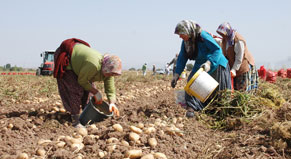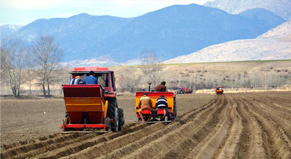Potato Farming
Potato is a plant that is at least as important as wheat and rice in human nutrition. It is main nutritional source of many nations in Europe and America with its high carbohydrate content.

Techniques to grow potato
Due to starch, protein, vitamin B1, B2 and C and some mineral substances in its content, potato is a plant which is used as industrial raw material and consumed by human most after grains. Potato is produced in different regions in our country because it can be adapted to various climatic conditionseasily, it is cheap, high yield is obtained from unit area when compared to alternative plants, its nutritional value is high. For high yield and quality production, many growing techniques from selecting growing area to soil preparation, from variety selection to fertilization and irrigation, from fighting against disease to rotation should be applied correctly.
Troubles had in Niğde and Nevşehir regions in potato production caused potato production to shift towards Konya region. Konya region has been producing 7% of Turkey’s potato production since 2010 and with an average yield of 3.7 tons/da, it has a yield value above country's average.
Seed and Variety Selection

Disease-free starting material is the most important part of potato farming. Many factors such as region, climatic factors, market status have effect on potato varieties to be grown. Grower should decide what kind of product he wants to obtain in advance and determine production purpose in advance. While making this decision, conditions of the region where production will be made should be taken into consideration. Variety should be decided depending on production for industry, food or seed.
Using quality and disease-free seeds is an important and necessary condition for potato. It is also important to use healthy seed tubers as well as high yield varieties in order to obtain high yield in potato farming. No matter how high potential the selected variety has, if seed tubers aren’t healthy and don’t have desired characteristics, it isn’t possible to reach targeted yield. Potato diseases are generally carried by tubers and it isn’t possible to see symptoms of diseases on tubers with naked eye. Because of this reason, great care should be taken to ensure that seed tubers to be used in planting are certificated. Elite and original seed productions aren’t at sufficient levels in Turkey and this causes breakages in seed production chain. While there was 450.000 tons of certificated seed requirement for potato planting areas in our country in 2010, the amount produced and distributed was 70.000 tons.

In order to increase potato yield and production or at least to keep it at the same level, it is necessary to change seed every 3 years and use virus-free seeds. Main factor which generally restricts yield in our country is seed, not variety. Although Turkey is at important potato producer position, potato yield may decrease because of lack of improved local varieties, use of varieties brought from countries such as Germany and Netherlands, climatic differences even if their adaptability is high.
Rotation
Crop Rotation is very important to minimize the effects of disease and pests on potato farming areas. Also, sugar beet has a risk to increase intensity of soil borne diseases if potato is planted before and after it. Potato leaves a clean and well aerated soil because it is a hoe plant. Because of this reason, it has an important place in crop rotation turn. If potato is planted every year successively, intensity of soil borne diseases increases and yield decreases significantly. Because of this reason potato shouldn’t be planted in the same field every year successively.
Soil Preparation

As a result of continuous tillage of the soil at the same depth, 5-10 cm thick hard impermeable layer is formed just below tillage depth of the soil (20-25 cm) and this layer is called plow pan. This layer is an impermeable layer and while it doesn’t allow water and rainfall to go down and to be stored, plant roots can’t penetrate through this layer. Formation of plow pan with soil compaction causes significant decrease in plant growth and yield because it effects physical, chemical and biological structures of the soil. In order to break this layer, “subsoiler” is recommended in areas where soil is dry. Subsoiler should be applied to 50-60 cm deep when soil is dry, for example; in July, August.
This is very important for plants which form tubers under the soil such as potato. For tuber development of potato, well prepared and raised seed bed should be prepared and soil should be enabled to have loose structure. When soil is mellow in fall, it should be plowed in 20-25 cm deep with moldboard plow. When soil is mellow in spring, the field should be made ready for planting by preparing a loose seed bed with combination of sweep-rake.
Sowing and Planting Time
The factor that determines planting time is soil temperature. It can be started to plant when soil temperature reaches 8-10 degrees. Suitable planting time in Konya region is period between April 15-May 15. Tubers with 28-35 mm diameter should be used for seed production, tubers with 35-60 mm diameter should be used for normal production. Pesticide should be applied to seeds before planting. Planting depth should be 4-5 cm depending on the soil moisture and temperature. Tubers which are planted should be covered with at least 10-15 cm of soil. They should be planted deep when moisture isn't enough.
After tuber is planted in soil, shoots come from buds.
Plant consists of these shoots. It receives nutrients that it needs from this tuber which is planted as a seed until it receives nutrients from soil. Numbers come out of one potato plant. Interrow spacing should be 70 cm, intrarow spacing should be 20-25 cm for seed potato production, 30-40 cm for food potato production.
Click to download the book titled “Farmer’s Guide to Plant Production”.
